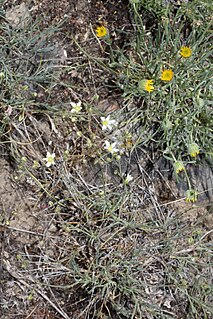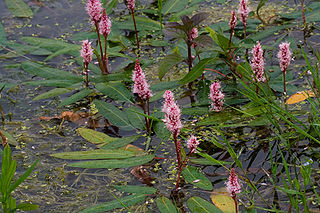
Ammophila is a genus of flowering plants consisting of two or three very similar species of grasses. The common names for these grasses include marram grass, bent grass, and beachgrass. These grasses are found almost exclusively on the first line of coastal sand dunes. Their extensive systems of creeping underground stems or rhizomes allow them to thrive under conditions of shifting sands and high winds, and to help stabilize and prevent coastal erosion. Ammophila species are native to the coasts of the North Atlantic Ocean where they are usually the dominant species on sand dunes. Their native range includes few inland regions, with the Great Lakes of North America being the main exception. The genus name Ammophila originates from the Greek words ἄμμος (ámmos), meaning "sand", and φίλος (philos), meaning "friend".

Caryophyllaceae, commonly called the pink family or carnation family, is a family of flowering plants. It is included in the dicotyledon order Caryophyllales in the APG III system, alongside 33 other families, including Amaranthaceae, Cactaceae, and Polygonaceae. It is a large family, with 81 genera and about 2,625 known species.

Ammophila arenaria is a species of flowering plant in the grass family Poaceae. It is known by the common names marram grass and European beachgrass. It is one of two species of the genus Ammophila. It is native to the coastlines of Europe and North Africa where it grows in the sands of beach dunes. It is a perennial grass forming stiff, hardy clumps of erect stems up to 1.2 metres (3.9 ft) in height. It grows from a network of thick rhizomes which give it a sturdy anchor in its sand substrate and allow it to spread upward as sand accumulates. These rhizomes can grow laterally by 2 metres in six months. One clump can produce 100 new shoots annually.

Ammophila breviligulata is a species of grass native to eastern North America, where it grows on sand dunes along the Atlantic Ocean and Great Lakes coasts. Beachgrass thrives under conditions of shifting sand, sand burial, and high winds; it is a dune-building grass that builds the first line of sand dunes along the coast. Beachgrass is less vigorous in stabilized sand, and is only infrequently found further inland than the coastal foredunes. On the Atlantic coastline of North America, Ammophila breviligulata has been observed as far south as North Carolina, and is often planted in dune restoration projects. Ammophila breviligulata was introduced to the Pacific coast of North America in the 1930s. It is proving to be invasive, and is increasingly important to coastal ecology and development in Oregon, Washington, and British Columbia.

Eremogone aculeata is a species of flowering plant in the family Caryophyllaceae known by the common name prickly sandwort. It is native to the western United States, where it grows in the southern sagebrush steppe, mountainous areas, and volcanic soils, as well as on rocky slopes.

Eremogone congesta is a species of flowering plant in the family Caryophyllaceae known by the common name ballhead sandwort. It is native to western North America from central Canada to the American southwest.
Eremogone macradenia is a species of flowering plant in the family Caryophyllaceae known by the common names Mojave sandwort and desert sandwort.

Eremogone ursina is a species of flowering plant in the family Caryophyllaceae known by the common name Bear Valley sandwort.
Minuartia californica, commonly known as California sandwort, is a species of flowering plant in the family Caryophyllaceae.
Minuartia howellii is an uncommon species of flowering plant in the family Caryophyllaceae known by the common names Howell's stitchwort and Howell's sandwort.
Minuartia pusilla is a species of flowering plant in the family Caryophyllaceae known by the common names annual sandwort and dwarf stitchwort.

Minuartia stolonifera is a rare species of flowering plant in the pink family known by the common names Scott Mountain sandwort and stolon sandwort.

Moehringia macrophylla, commonly known as the largeleaf sandwort, is a species of flowering plant in the family Caryophyllaceae. It is native to parts of eastern and western North America, where it can be found in moist, shady habitat types, such as mountain forests. It is a rhizomatous perennial herb growing erect to about 18 centimeters in maximum height. The lance-shaped leaves are up to 5 centimeters long and oppositely arranged about the stem. The inflorescence is a cyme of 2 to 5 flowers, each with 5 pointed green sepals and 5 rounded white petals. The fruit is a toothed black capsule.

Phacelia insularis, the coast phacelia is a rare species of phacelia. It is endemic to California, where it has a disjunct distribution.

Persicaria amphibia is a species of flowering plant in the knotweed family known by several common names, including longroot smartweed, water knotweed, water smartweed, and amphibious bistort. It is native to much of North America, Asia, Europe, and parts of Africa, and it grows elsewhere as an introduced species and sometimes a noxious weed.
Polygonum marinense is a rare North American species of flowering plants in the buckwheat family known by the common name Marin knotweed. It is endemic to California, where it is known from just a few locations north and east of San Francisco Bay.

Sagittaria sanfordii is an uncommon species of flowering plant in the water plantain family known by the common names valley arrowhead and Sanford's arrowhead. It is endemic to California, where it is known from a few scattered occurrences on the North Coast and in the Central Valley. Many occurrences previously noted in the Central Valley and in southern California have been extirpated as the plant's aquatic habitat has been lost to human activity.
Streptanthus insignis is an uncommon species of flowering plant in the mustard family known by the common names plumed jewelflower and San Benito jewelflower. It is endemic to California, where it is known only from the Inner Central Coast Ranges. It grows in grassland and chaparral habitat, usually on serpentine soils. It is an annual herb producing a hairy, bristly, branching stem up to about 60 centimeters long. The lance-shaped basal leaves are borne on short petioles. Leaves midway up the stem are longer, and those near the top are shorter. They sometimes clasp the stem at their bases. Flowers occur at intervals along the upper stem. The uppermost flowers are often sterile and different in form. Each fertile flower has a bell-shaped calyx of sepals which is purple or greenish-yellow depending on subspecies. The petals at the tip are purplish or yellowish, also depending on subspecies. The fruit is a flat, straight silique which may be over 11 centimeters long.

Suaeda californica is a rare species of flowering plant in the amaranth family known by the common name California seablite. It is now endemic to San Luis Obispo County, California, where it is known from a few occurrences in the marshes around Morro Bay, historical populations around San Francisco Bay have been extirpated.

Minuartia cumberlandensis is a rare species of flowering plant in the pink family known by the common names Cumberland stitchwort and Cumberland sandwort. It is endemic to the Cumberland Plateau near the Big South Fork of the Cumberland River in Tennessee and Kentucky. This rare plant is found only in cool sandstone rock shelters, on the moist sandy cave floors behind the drip line. There are 27 occurrences in Tennessee and one in Kentucky. The plant is a federally listed endangered species.















